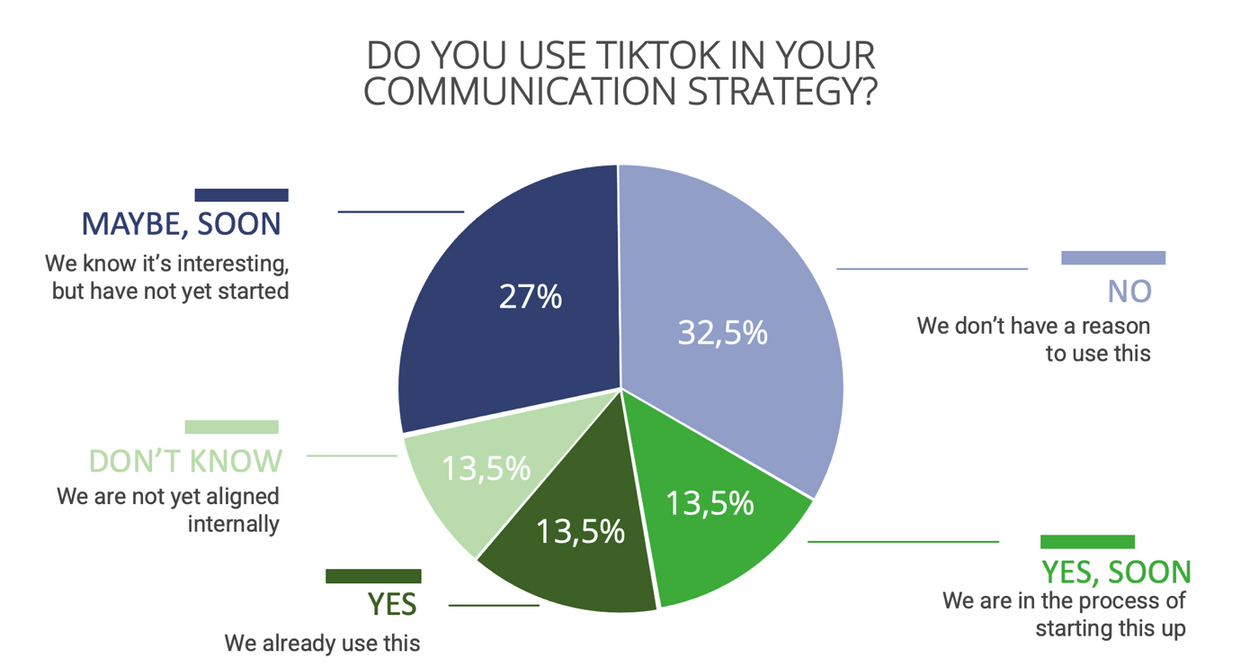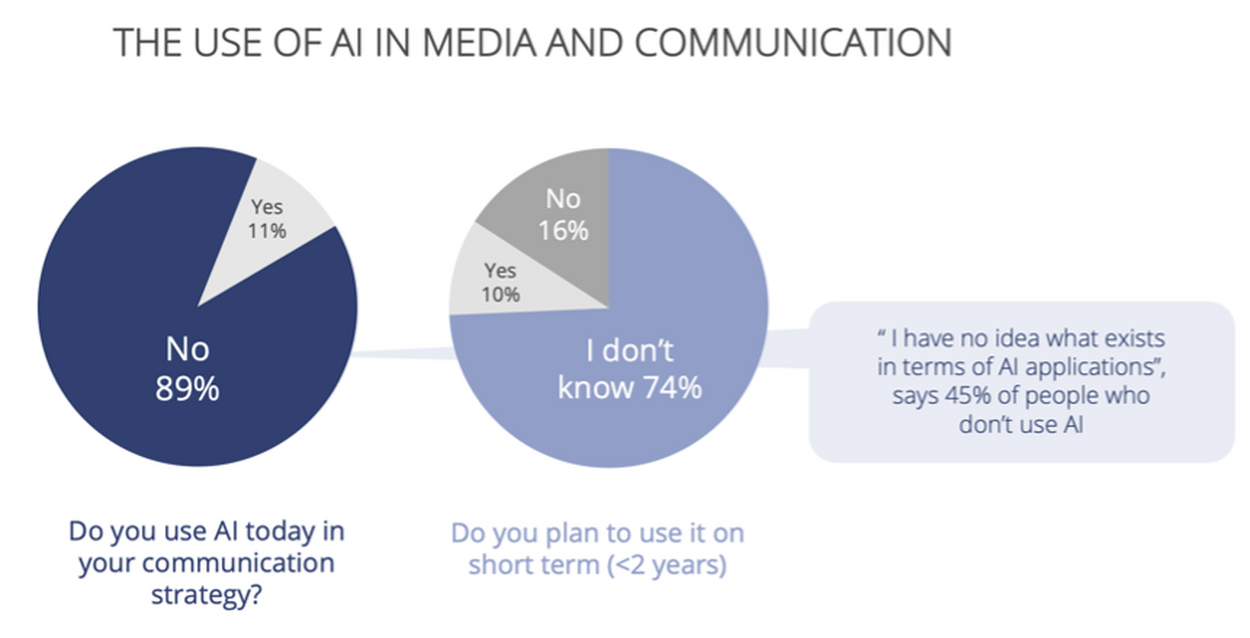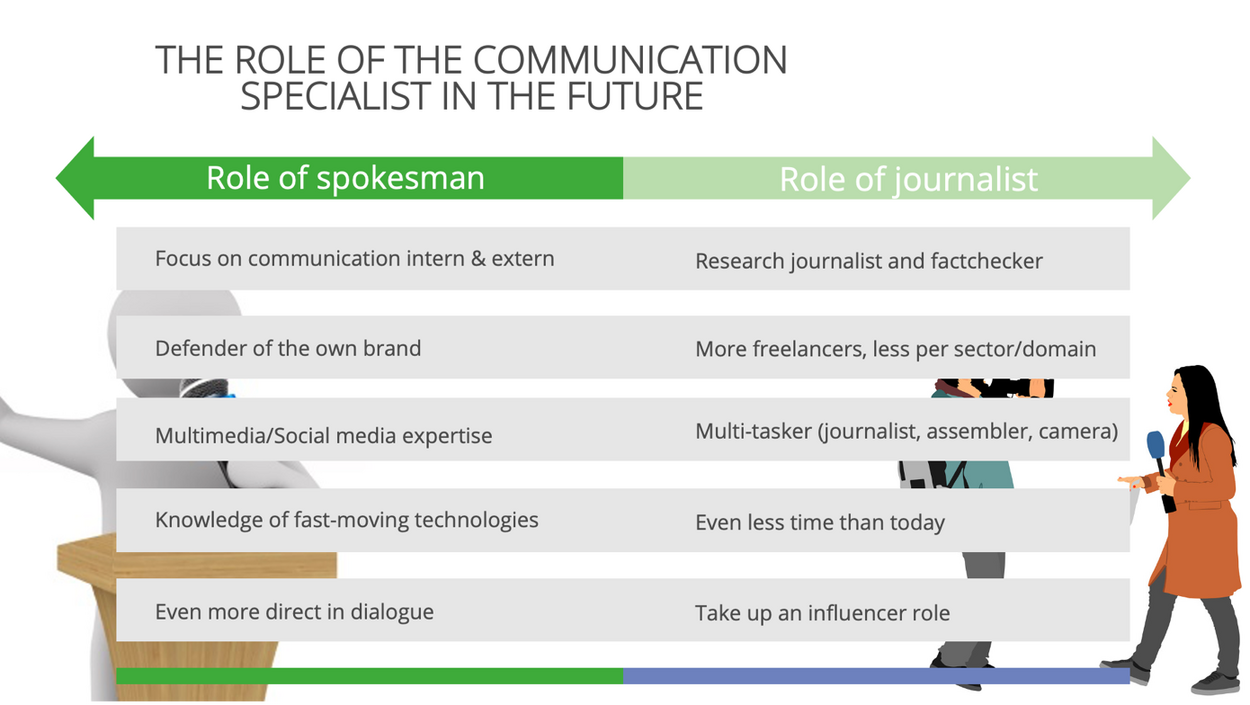Maybe more than any other business, communication, press and media are transforming rapidly as a result of technological advancement, such as Artificial Intelligence. How do professionals cope with this changing context? What is the impact on their role? And how will skills be shifting in the future? TomorrowLab and BelgaClub (Network of Belgian Spokespersons) yielded some interesting insights from a survey into the matter.
Tomorrowlab and BelgaClub conducted an online survey and one-one interviews with journalists and marketing & communication professionals, spokespersons and press officers in the public and private sector about the changes and evolutions in their field. So what is exactly the context in which all this technological innovation is taking place?
- Speed: Covid has accelerated digitalisation. The end user also expects a much faster response because people communicate more directly.
- Increased volatility or brevity has its advantages and disadvantages. You can’t miss the boat, but people also forget more quickly.
- Fragmentation of communication: losing control because of the multitude of news platforms. A spokesperson will have to defend the brand or organisation more.
- Knowledge and skills: more will be required of communication specialists in terms of domain knowledge, but also with regard to skills and tools. Too much for 1 person?
- Communication is key: small and medium-sized companies are more aware of and investing in communication. Large companies are shifting to more rock ‘n roll communication.
- Credibility: it is becoming increasingly difficult to be believed. Again this increases the need for the brand defender, an influencer of sorts, with the emphasis on correct data and reliable information.
As a consequence of this new and changing paradigm, companies and media are constantly questioning and rethinking their communication strategies. What dominant trends and shifts can we conclude from the survey? Of course there are many more, in this blog we limit ourselves to 3 major trends that can give companies some bearing in turbulent times.
1. Social media and the generation gap
Although 8,4 out of 10 Belgians are 'social media savvy', there are important differences in terms of engagement between generations. That is hardly surprising of course, but the trend of millennials being influenced by a stranger on the consumption of products or news, is not likely to disappear. Among the biggest challenges in that respect, respondents mention fake news and disinformation, finding independent sources, and clickbait with misleading titles for mere advertising exposure. It is important to keep young people involved with short videos, by use of influencers and through interactivity and engagement.
One platform really sticks out though. With its 2.7 million users in Belgium and a 29% engagement rate, TikTok is the challenging platform to include in the communication strategy. Although companies are still hesitant to do so, it could certainly be worth considering in the long run. Today, it is not yet possible to advertise on TikTok in Belgium; only a few communication agencies can do so because of partnerships with Asia. But there are other possibilities, such as using influencers or the #challenges. Het Rode Kruis for example gained more than 83K followers and 1M likes thanks to short first aid related videos. They reached their goal: informing people in an instructive way.

2. AI in media and communication
Artificial Intelligence is still only marginally used by companies in their communication strategy today. 89% indicate that they do not use it, and the majority of them do not know if they will in the future. Maybe it has to do with Stephen Hawking’s rather fatalistic view. "The development of full artificial intelligence could spell the end of the human race". So how can we turn AI to our advantage? This is where the crux of the matter is. 45% admits to lacking the knowhow to measure the engagement of the target group or which tools to use.
However, there are many opportunities with AI. For example, at the start of the Covid pandemic, a Spanish government agency received so many questions that they could not manage any more. They wrote AI software that analysed the questions, clustered them and provided FAQ. In this way, they quickly got a grip on the situation.
Similarly for the press landscape. “The newsroom of the future is one where journalists can focus on finding and telling great stories, something that machines can’t do”, said David Walmsley, editor-in-chief for The Globe and Mail. Meaning that data scientists can automate webpages to generate real-time engagement measure of the target group. When asked what could be the use of AI in journalism, respondents see 3 main pluses (Knigh foundation):
- Augmented reporting capacity: combing through large document dumps with machine learning i.e. detection of breaking news, data from website
- Reducing variable costs: automation tools for transcription process, tagging of video and image and story generation
- Optimizing revenue: dynamic paywalls, recommendation engines and digitization of news archives
Some concrete examples?
- Quakebot: LA Times has written AI software that allows them to reduce variable costs. Based on predefined criteria, automatic reports are made about earthquakes.
- Robotmade: The Guardian is currently doing pilots with an open AI language generator. In this way a full-fledged article was written without any human intervention, titled: 'why shouldn't humans be afraid of robots'.
- Sophi Automation: The Global and Mail in Canada works with AI software to analyse and monitor every article and advertisement. 99% of their content on the website is generated based on this analysis. In this way, they could free up their journalists for more research and news production.

3. The new role of communication professionals
Web 2.0 was driven by 3 core layers of innovation: Mobile first (always on), Social networks and the Cloud-driven computing. Now we are witnessing a shift towards Web 3.0, characterized by a leap forward to Open, decentralized data architecture, AI-driven service and Edge computing. Indeed, that inherently affects the role of the spokespersons and journalists in the future. We asked them what is important in a sound communication strategy.
- Emotion: capitalising on people's feelings. The coffee brand Douwe Egberts has created a number of great campaigns around this.
- Humour: people need positivity. A touch of humour, like at bol.com, can help. Provided this fits with the brand identity.
- Putting the customer first. IBM says: whoever uses our products, is successful.
- Authenticity: brands such as Bristol and Colruyt are exemplary in authentic communication
- No-nonsense: Volvo developed strong campaigns about their car brand and the climate challenges.
- Keep the organisation's goal in mind. Less is more. Some companies communicate in a limited way, but mainly when it really matters.
So, what will likely be the impact of all this on their role? On the one hand, the spokesperson will be required to focus more on both internal and external communication, be a defender of the own brand with extensive multimedia/social media expertise and more direct dialogue. The journalist will have to become a combination of an expert-factchecker and reporter, freelancing more and multitasking (journalist, editing, camera), while also taking up an influencer role from that expert perspective.

We would like to close with a tip of our own: “If you snooze, you lose”. Don’t fall asleep and keep innovating! Experiment with (new) social media channels, embrace technologies and test wherever possible. This can help to keep that critical mass of information above you.

